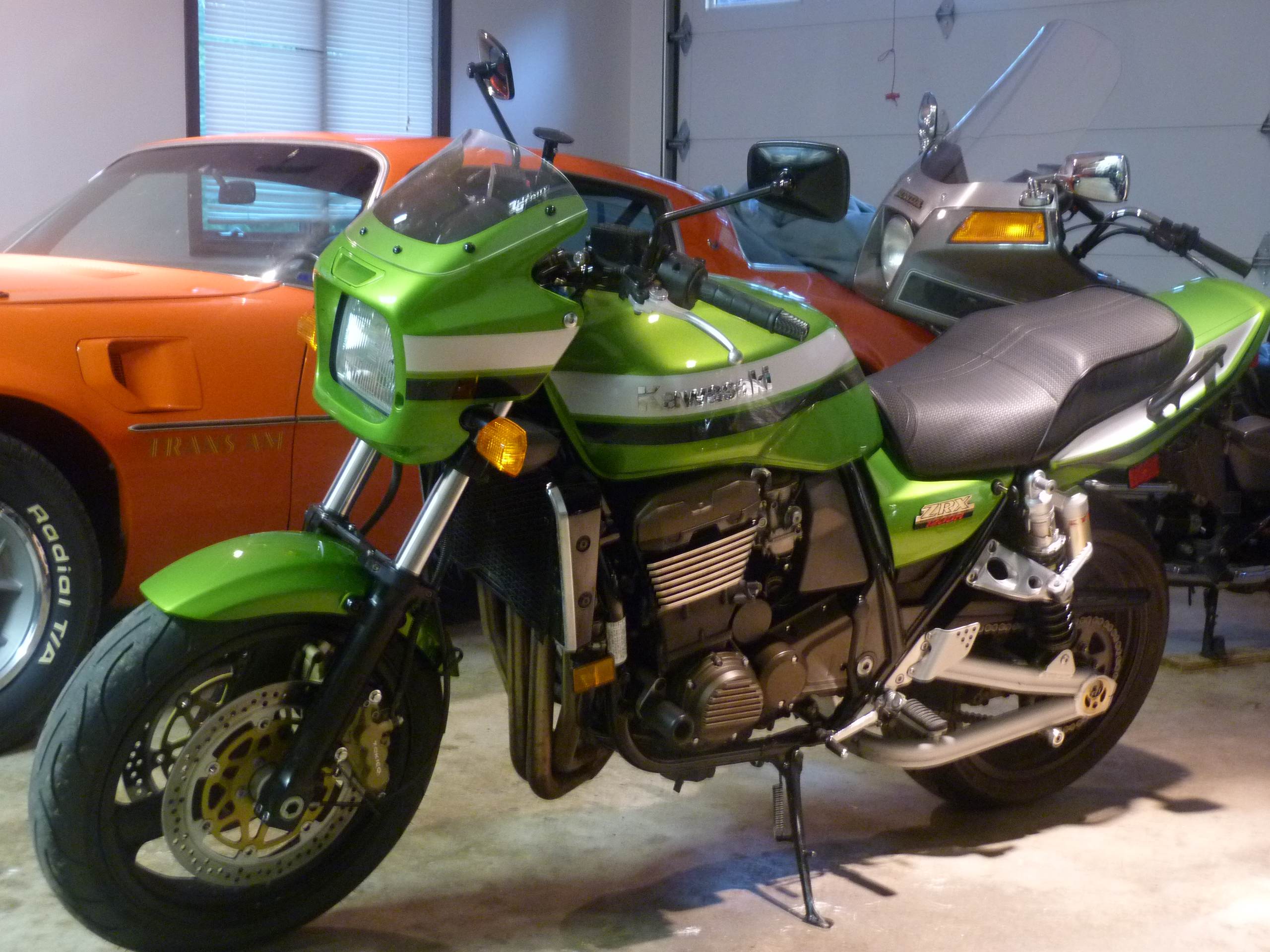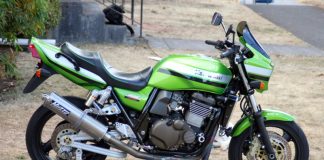I bought my ZRX1200 brand-new, back in ’03. It seems like yesterday – but it was a lot longer ago than yesterday that I gave the front end a good going-over.
Thank the motor gods for short-lived tires.
I needed a new front meat (the rear one got replaced last fall) so the other day I pulled the wheel and off to the bike shop I went. Some guys take their bikes to the shop. I prefer to take just the wheel. I’m a hands-on kind of guy, because if there’s a screw up I prefer to know I did it.
This makes revenge simpler.
It also causes me to notice stuff. Like the nearly vaporized brake pads. I checked the little notebook I keep for the bike (I keep one for each bike) in which I record everything done, maintenance-wise, along with the date and mileage at which it was done. New pads just last year. That’s what I remembered. And because I’d put in new pads pretty recently – by the book – I’d have inclined to not even think about them at this point, had it not been for that short-lived tire, which kind of forced me to at least glance at those calipers.
Yikes!
Maybe one more serious stop left in those old pads. Coming down from 160-ish like a 747 with only so much runway room left eats them up pretty fast. It pays to look at them more often.
Point taken.
That got me to thinking about the forks. When had I last changed the oil, checked the internals? Gawd. My eyes are still good but my memory never has been. Five years, according to the book.
Too long.
Good time to fix that, while the wheel’s off.
The job itself is easy . . . once you have the bike’s front end in the air. Sport bikes have few jacking points and they like to tip over, too.
Be seriously careful, if you’ve never done this before.
On my bike, there is one possible jacking point underneath the bike, ahead of the center of gravity – important, so that when you (gently) raise the nose, the weight transfers to the rear wheel. Otherwise, the rear end will rise – or both ends will rise – and then you’ve got several hundred pounds of bike with both wheels off the ground, precariously balancing on the jack . . . an almost sure-bet guarantee it’s going to topple over and ruin your day.
Of course, you could use a bike lift. But this is a tool even I lack, so I’ve learned to improvise.
Using a small floor jack (it fits in tight places more easily) and small block of wood – to cushion between the hard steel jack and the soft aluminum of the engine’s cases – find that sweet spot forward of the bike’s center of gravity. Look for a flat spot on the underside of the engine. Do not place the jack under a bolt or any portruding thing that might get crushed.
But, first, know your support points. And have a pair of jackstands at the read, on either side of the bike. When you raise the bike with the jack, it will get wobbly. Ideally, you’ll have a helper on hand to stabilize the thing, to keep it from falling over. I’m a long-armed geek, so I do this – jack the bike up and hold the bike steady – all by myself. It’s probably not smart, but – so far – I have managed to get away with it.
Raise the front end up just enough to fully extend the forks and get about two inches of air underneath the front tire. Now, slide those jackstands underneath something solid on either side of the bike. On my bike, I’ve got aftermarket frame sliders on either side, just ahead of the gearshift lever/rear brake lever. These are perfect places to slide jackstands under and support the weight of the bike while the front wheel’s off and the front end disassembled.
You’ll want – you’ll need – something like this in order to do this deed without a by-the-book motorcycle lift. Don’t begin until you’ve planned – and have the whole thing laid out in your head, along with every tool you’ll need. Most especially the jackstands – and a place to put them under.
That done, pulling the forks is a simple matter of loosening the triple tree clamps, then grabbing the tubes (not the lowers) with both paws and rotating them as you exert downward pressure. They ought to slide right out. But before you do this – loosen the clamps – you’ll want to loosen the top cap, which may otherwise prove to be very hard to loosen once the forks are out of the vise-like grip of the triple trees. And you’ll need them loose – and off – to refill the forks with fresh oil. If your bike’s like my Rex, you’ll need the caps off to drain the forks, too. Because there’s no drain hole built into the lowers (other bikes I’ve got do have drain screws on the lowers).
Whatever you do, do not put the fork tubes in a vise to keep them still while you try to wrestle off the caps. This is a great way to ruin the tubes.
From here forward, you’ll want to consult the shop manual for your particular bike, paying particular attention to fork oil capacity (make sure you get it exactly right, using a graduated beaker) and also because there are lots of small parts that come off and have to be re-assembled in exactly the right order – and exactly according to procedure. Disassemble one fork at a time – and you’ll have one fork still assembled as a reference. But don’t guess or improvise. Screwing up one or both forks could result in a very evil-handling ride.
Once you’re sure everything’s been put back together the right way (double check your work), slide the tubes back into the triple trees – making certain they’re exactly even – tighten the bolts and you’re ready for the rim with its new tire (in my case) and (again) those new brake pads.
Which will not last long in my hands . . . but isn’t that the object of this exercise?
Throw it in the Woods?











I have done multiple fork rebuilds(and spring upgrades, I’m too cheap for internals except in my race bikes, I usually just up the fork oil weight in many cases for street work) on a variety of bikes.
I like using tie down straps on the triple tree and lifting it from above, the cheap way being using a ratcheting strap(attach it to a beam in your garage) or if you have a cherry picker about, using that. It solves many problems and it’s pretty easy to do….works on a lot of bikes…if the handlebars aren’t clip on style you can use them for a lifting point too.
Also, I’ve found sonic springs to be pretty cheap and an easy upgrade for bikes as opposed to some other brands, they actually made some custom springs from me the other year pretty inexpensively.
Kudos to you Eric on the use of Maxima oils(I’m assuming it’s synthetic, can’t see the writing on the bottle)…I did some research and their syn oil is super stable/consistent for the price.
Hi Nick,
I never cheap out on fluids for my bikes!
The Rex has the Muzzy stainless exhaust, Ivan’s jet kit/air box mods. I’m lusting after the Ohlins forks/shocks, though. Expensive as hell – but a lot less than a new bike!
Have you thought about installing ZZR cams in yours?
I gather it’s worth about 10-15 on a bike with the above mentioned mods.
But those cams are hard to find….
Oops!
I didn’t mean to suggest I have a Rex(great bike though!). I’ve just done several fork rebuilds and usually the strap method on the bar or triple tree worked great on all of them.
I’ve only done a cam swap on a Husaberg, my former race bike(R6) just needed cam timing/degreeing…not really sure of the profile differences on the Rex versus the ZZR, but off the top of my head if you really want to go that far I’d suggest sending them off to Megacycle after calling them to see what they can do as far as a reprofile goes….
I usually don’t do much on street bikes beyond the standard jet kit/chip and exhaust because the dollar/gain ratio isn’t usually worth the hassle on the street.
Jim Doer at Megacycle is a great person to work with. He made a set of cams for my Duck racer many years ago. Took an Imola intake lobe, mated it to a SS exhaust lobe, rolled the cam centers in and the bike made a ton of power. Too bad the bevel drive cases are only good for 85 HP, they tend to break the right cases. Jim has kitted a lot of fast bikes.
Dale Alexander
This was beautiful: “Took an Imola intake lobe, mated it to a SS exhaust lobe, rolled the cam centers in and the bike made a ton of power.”
You guys who do that sorta shit.
And, the ah, Sensei who make it happen.
You’re great.
I’m in awe every time I meet up with one of you all.
Me too, Helot..
Making a cam is something I’ve yet to even try . . . kudos to anyone who has done it!
Great stuff, Dale –
It’s a new angle to pursue.
To date, I’ve found three options:
Find a pair of used ZZR1200 cams (very tough to do as the word is out and REXers are on the prowl for these).
Buy the Muzzy cams (very expensive and not really suitable, apparently, for an otherwise stock engine; really needs higher CR pistons etc. to work properly).
Buy the Yoshi race cams…
Custom-ground cams might be the ticket…
With 180 or so hp, a ZRX would be a fast-lane ride to Hades! Probably the next-best thing to an H2 750 as far as keeping you from getting sleepy….
My super safe simple one man (at least up) ZRX jacking tip.
(if you do this and drop it don’t blame me….I have done it dozens of times)
Grab two jackstands with rachet locking mechanisms, tape, rags, zip ties.
Tape padding to the tops of jackstands neatly, leaving space for frame rails to sit.
Position the first along the frame on the right side while bike is on kickstand. You may have to lean it over some more.
Zip tie the jackstand to the frame rail tightly.
Prepare your left jackstand.
Standing on the left lean the bike to the right and slide the stand under the frame rail.
Zip tie the stand to the frame rail.
Now lean left until right stand clicks once….
Lean right until left stand clicks once….
repeat.
To get it down you will need a helper to lower one click at at time..but I have done it alone by taking weight off, releasing latch, lowering slightly and letting latch engage.
I redid my ZRX forks with 1.1 springs and new oil. New rear shocks sprung for my fat ass and the bike is wonderful!!!!
I will never part with my REX….
Good stuff, Ric!
I also will never part with my Rex. Love the bike.
I do, however, look with lust at that Muzzy top end kit… 180 hp at the wheel!